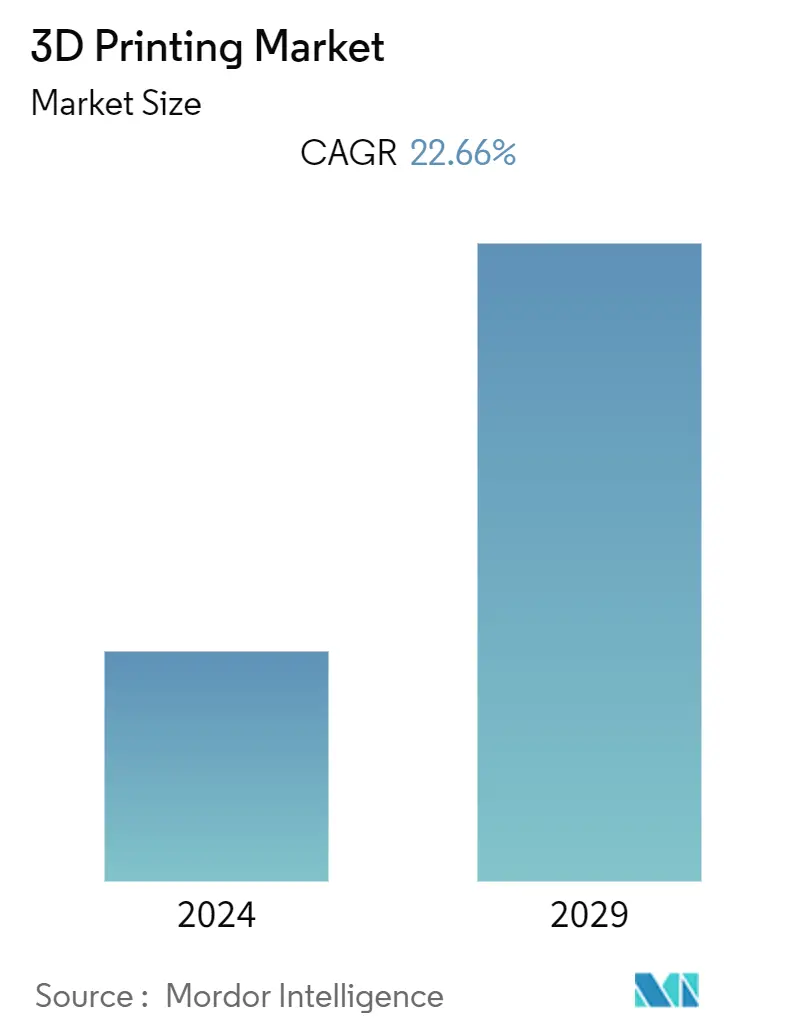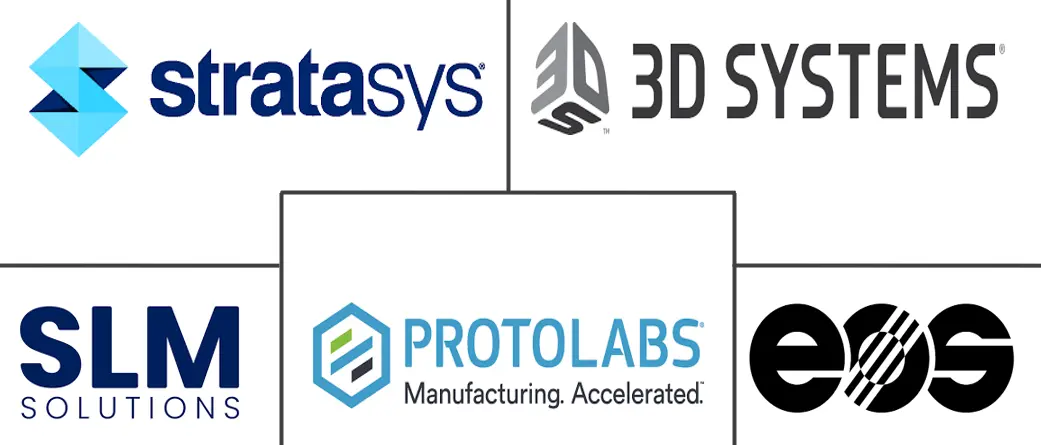Market Size of 3D Printing Industry

| Study Period | 2019 - 2029 |
| Base Year For Estimation | 2023 |
| CAGR (2024 - 2029) | 22.66 % |
| Fastest Growing Market | Asia Pacific |
| Largest Market | North America |
| Market Concentration | Low |
Major Players
*Disclaimer: Major Players sorted in no particular order |
3D Printing Market Analysis
The 3D Printing Market is expected to register a CAGR of 22.66% during the forecast period.
This growth of the 3D printing market is pinned to the trend that large manufacturers are increasingly using the technology for mass production.
- With rapid advancements in material composition, such as the emerging use cases of polymers and metals, additive manufacturing is evolving from a prototyping tool to a functional part of fabrication. New materials, shorter lead times, and innovative finishes while adhering to standards (FDA, ASTM, and ISO) enable the technology to be integrated into manufacturing processes.
- Further, the decreased prices of additive manufacturing-based machines, growing expertise, and awareness have increased 3D manufacturing adoption. Newer and advanced fused deposition modeling methods have enabled the use of diverse materials, thereby boosting widespread adoption across various industries over recent years.
- Governments worldwide have already started investing in R&D on 3D printing, which has positively impacted technology propagation and adoption. For instance, in February 2022, the government of India aims to capture 5% of the global market share in 3D printing by adding nearly USD 2-3 billion to the GDP in the coming 2-3 years. The government plans to create 50 India-specific technologies for material, machine, process, and software to make India a 3D-printed design and manufacturing hub.
- However, as technology advances, additive manufacturing challenges the traditional forms of Intellectual Property (IP) protection. It significantly boosts the illegal usage of printed weapons and drugs, which is expected to hinder the market's growth. Also, the market is constrained by the high equipment costs needed to achieve substantial economies of scale. Furthermore, the lack of an international standards body regulating manufacturers limits the market's standardization structure.
- COVID-19 pandemic increased the demand for 3D printing. 3D printing systems are rapidly being utilized to create medical devices, personal protective equipment (PPE), testing devices, and even emergency dwellings to isolate persons suffering from the disease. The various technological advancements, such as AI and ML, further augment the adoption of 3D Printing devices.
- The pandemic hit the metal and polymer 3D printing markets hard. Whereas growth has been slower for metals and polymers than pre-pandemic expectations, these markets are returning rapidly with growing demand from end-user industries.
3D Printing Industry Segmentation
Additive manufacturing, or 3D printing, is an automated process of creating rapid prototypes and functional end-use parts. It transforms virtual designs from computer-aided design (CAD) software into thin, virtual, horizontal layer-wise cross-sections until the model is complete. The 3D printing market's scope categorizes the various technologies used in 3D Printing, ranging from SLA, FDM, SLS, DLM, EBM, etc.
The study also categorizes an in-depth analysis of multiple applications of 3D Printing across various end-user industries, such as automotive, aerospace, defense, healthcare, construction, and architecture. The categorization is also based on material types, such as metals, plastics, and ceramics.
The 3D Printing Market is segmented by printer type (desktop and industry-grade), technology (stereo lithography, fused deposition modeling, electron beam melting, digital light processing, and selective laser sintering), material type (metal, plastic, and ceramics), end-user industry (automotive, aerospace, and defense, healthcare, construction and architecture, energy, and food), and by geography.
The market sizes and forecasts are provided in terms of value (in USD) for all the above segments.
| By Technology | |
| Stereo Lithography (SLA) | |
| Fused Deposition Modeling (FDM) | |
| Electron Beam Melting | |
| Digital Light Processing | |
| Selective Laser Sintering (SLS) | |
| Other Technologies |
| By Material Type | |
| Metal | |
| Plastic | |
| Ceramics | |
| Other Material Types |
| By End-user Industry | |
| Automotive | |
| Aerospace and Defense | |
| Healthcare | |
| Construction and Architecture | |
| Energy | |
| Food | |
| Other End-user Industries |
| By Geography | |
| North America | |
| Europe | |
| Asia-Pacific | |
| Rest of the World |
3D Printing Market Size Summary
The 3D printing market is experiencing significant growth, driven by the increasing adoption of additive manufacturing technologies across various industries. This expansion is largely attributed to the technology's evolution from a prototyping tool to a vital component in manufacturing processes, facilitated by advancements in material composition and printing techniques. The integration of new materials like polymers and metals, along with innovations such as fused deposition modeling, has broadened the application of 3D printing in sectors like automotive, aerospace, and defense. Additionally, the reduction in machine costs and the growing expertise and awareness among manufacturers have further propelled the market's adoption. Government investments in research and development, particularly in regions like India, are also contributing to the market's growth by aiming to capture a significant share of the global market and develop India-specific technologies.
Despite the promising growth trajectory, the 3D printing market faces challenges, including issues related to intellectual property protection and high equipment costs, which can hinder economies of scale. The lack of international standards for manufacturers also poses a challenge to market standardization. The COVID-19 pandemic has spurred demand for 3D printing in producing medical devices and PPE, highlighting its versatility. The North American region is poised to dominate the market due to its early adoption of technology and ongoing investments in sectors such as healthcare and aerospace. Key players in the market are actively engaging in partnerships, mergers, and acquisitions to strengthen their positions, with companies like Stratasys Ltd. and 3D Systems Corporation leading the charge. These developments, coupled with the increasing need for customization and the introduction of advanced materials, are expected to drive the market's growth in the coming years.
3D Printing Market Size - Table of Contents
-
1. MARKET DYNAMICS
-
1.1 Market Drivers
-
1.1.1 Initiatives and Spending by the Government
-
1.1.2 Ease in Development of Customized Products
-
-
1.2 Market Challenges
-
1.2.1 High Initial Cost and Skill Shortage
-
-
-
2. MARKET SEGMENTATION
-
2.1 By Technology
-
2.1.1 Stereo Lithography (SLA)
-
2.1.2 Fused Deposition Modeling (FDM)
-
2.1.3 Electron Beam Melting
-
2.1.4 Digital Light Processing
-
2.1.5 Selective Laser Sintering (SLS)
-
2.1.6 Other Technologies
-
-
2.2 By Material Type
-
2.2.1 Metal
-
2.2.2 Plastic
-
2.2.3 Ceramics
-
2.2.4 Other Material Types
-
-
2.3 By End-user Industry
-
2.3.1 Automotive
-
2.3.2 Aerospace and Defense
-
2.3.3 Healthcare
-
2.3.4 Construction and Architecture
-
2.3.5 Energy
-
2.3.6 Food
-
2.3.7 Other End-user Industries
-
-
2.4 By Geography
-
2.4.1 North America
-
2.4.2 Europe
-
2.4.3 Asia-Pacific
-
2.4.4 Rest of the World
-
-
3D Printing Market Size FAQs
What is the current 3D Printing Market size?
The 3D Printing Market is projected to register a CAGR of 22.66% during the forecast period (2024-2029)
Who are the key players in 3D Printing Market?
Stratasys Ltd., 3D Systems Corporation, Proto Labs Inc., SLM Solutions Group AG and EOS GmbH are the major companies operating in the 3D Printing Market.

